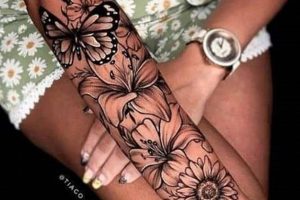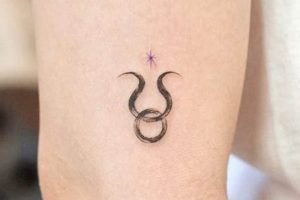Simple, timeless designs comprise the foundation of introductory body art. These often include small, easily recognizable symbols, single words, geometric shapes, minimalist line drawings, or small depictions of flora and fauna. Examples include outlines of hearts, stars, arrows, anchors, or short quotations.
Opting for uncomplicated designs offers several advantages. They typically require less intricate execution, resulting in shorter sessions and lower costs. Their streamlined nature makes them versatile for placement on various parts of the body. Furthermore, simpler artwork tends to age better, requiring fewer touch-ups over time. Historically, many fundamental designs have cultural significance, adding a layer of personal meaning. These straightforward concepts serve as an excellent starting point for individuals new to permanent body modification.
This article will delve into various categories of uncomplicated designs, offering guidance on selection, placement, and artistic considerations.
1. Meaningful Symbolism
Imbuing even simple designs with personal significance elevates them beyond mere aesthetics. Meaningful symbolism connects the wearer to their chosen artwork on a deeper level, transforming a basic tattoo into a personal statement. This connection fosters a stronger sense of appreciation and enduring satisfaction.
- Cultural Heritage:
Many cultures possess rich traditions of symbolic imagery. Incorporating these elements can represent a connection to one’s ancestry or cultural values. Nordic runes, Celtic knots, or Japanese kanji, even in simplified forms, can carry profound cultural weight and offer a visual representation of heritage. Choosing such designs requires careful research to ensure accurate representation and respectful usage.
- Personal Experiences:
Life events, passions, and personal beliefs can be distilled into symbolic representations. A simple wave can signify a love for the ocean, a single feather can represent freedom, or a small compass can symbolize a journey of self-discovery. Abstract shapes or minimalist depictions of significant objects offer subtle yet powerful expressions of personal narratives.
- Abstract Concepts:
Fundamental human values like love, hope, or resilience can be expressed through abstract symbols. Interlocking circles might represent unity, a semicolon can symbolize perseverance, or a minimalist triangle can signify strength and stability. These abstract forms offer a versatile way to convey complex emotions or concepts concisely and artistically.
- Relationships and Loved Ones:
Small, symbolic designs can serve as tributes to important relationships. Initials, significant dates, or minimalist representations of shared interests can honor loved ones or commemorate meaningful connections. A simple heart outline, a small paw print, or a single, stylized flower can serve as lasting reminders of cherished bonds.
By carefully considering the symbolism embedded within a simple tattoo design, individuals can ensure a lasting connection to their chosen artwork. This thoughtful approach transforms basic designs into powerful personal statements, enriching the experience and enhancing the meaning carried on the skin.
2. Placement Considerations
Placement plays a crucial role in the overall impact and practicality of uncomplicated tattoo designs. Several factors influence optimal placement, including pain tolerance, visibility preferences, and how the design interacts with the body’s natural contours. Careful consideration of these elements ensures the tattoo complements the individual’s physique and aligns with their desired level of discretion.
Areas with more muscle or fat padding, such as the outer thighs, shoulders, or back, tend to offer a less painful tattooing experience. Bony areas like ribs, ankles, or fingers are generally more sensitive. Visibility also varies significantly depending on placement. A tattoo on the inner wrist is easily concealed, while one on the forearm is more readily displayed. Understanding these differences allows individuals to choose locations that align with their lifestyle and comfort levels. A small, geometric design might be well-suited to the inside of a finger, while a minimalist floral arrangement might complement the curve of a shoulder blade.
The size and shape of the design should also harmonize with the chosen body part. Elongated designs can accentuate the length of a limb, while smaller, circular designs might be better suited to areas like the wrist or ankle. Considering the body’s natural movement and how the skin stretches and folds is also essential. A design placed across a joint requires careful planning to ensure it maintains its visual integrity as the body moves. Successfully integrating these practical considerations ensures the longevity and aesthetic appeal of even the simplest tattoo designs.
3. Scalability and Detail
The interplay of scalability and detail is paramount when selecting a basic tattoo design. A design’s ability to retain its visual integrity at different sizes directly impacts its suitability for various placements on the body. Understanding this relationship ensures the chosen artwork translates effectively from concept to execution, maintaining clarity and impact regardless of its final dimensions.
- Simplicity in Design:
Simpler designs often scale more effectively. Clean lines, minimal shading, and solid color blocks retain their clarity even when reduced in size. Intricate details, on the other hand, can become muddled or lose definition when miniaturized. A simple outline of a mountain range translates well at a smaller scale, whereas a highly detailed forest scene might lose its impact.
- Line Weight and Boldness:
Appropriate line weight is crucial for scalability. Thin, delicate lines might fade or disappear over time, especially in smaller tattoos. Bolder lines generally hold up better, maintaining visibility and definition as the tattoo ages. A bold, simple anchor design will remain clear over time, while a fine-lined feather might require more frequent touch-ups.
- Color Considerations:
Color saturation and contrast affect a tattoo’s long-term visibility. Bold, solid colors tend to age better than subtle gradients or watercolor effects, especially in smaller designs. Darker colors also typically retain their vibrancy longer than lighter shades. A solid black heart will remain visually striking, while a pastel rainbow might fade more quickly.
- Placement and Proportion:
The chosen placement influences the appropriate level of detail. Larger areas like the back or thigh can accommodate more complex designs, while smaller areas like the wrist or ankle necessitate simpler, bolder artwork. A detailed portrait might be suitable for a larger canvas, but a small, symbolic design is more appropriate for a finger.
Careful consideration of scalability and detail ensures a basic tattoo design remains aesthetically pleasing and recognizable across a range of sizes. This understanding allows for effective adaptation of the chosen artwork to different body locations, preserving its intended impact and ensuring its longevity.
4. Timeless Aesthetics
Timeless aesthetics represent a crucial element in basic tattoo design. Choosing artwork that transcends fleeting trends ensures the tattoo remains visually appealing and personally relevant for years to come. This involves prioritizing classic imagery, clean lines, and fundamental design principles that withstand the test of time. A simple anchor, a geometric pattern, or a single word in a classic typeface are less likely to feel dated than a design based on current pop culture trends. These timeless elements offer a sense of enduring style, avoiding the risk of a tattoo becoming a regretful reminder of a bygone era.
Consider the enduring appeal of traditional tattoo styles. Classic Americana imagery, with its bold lines, vibrant colors, and iconic motifs like roses, anchors, and swallows, has maintained its popularity for decades. Similarly, Japanese traditional tattoos, featuring intricate depictions of dragons, koi fish, and cherry blossoms, retain their artistic and cultural significance across generations. These established styles offer a wealth of inspiration for basic tattoo designs that will remain visually compelling for years to come. Choosing a simple cherry blossom or a small, classic swallow offers a timeless aesthetic that avoids the pitfalls of trend-driven designs.
Prioritizing timeless aesthetics necessitates a focus on simplicity and clarity. Clean lines, balanced compositions, and a restrained use of color contribute to a design’s longevity. Overly intricate or highly stylized designs can appear dated more quickly, as stylistic trends evolve. A minimalist approach, emphasizing fundamental shapes and symbolic imagery, ensures the tattoo remains visually appealing and personally meaningful regardless of changing fashions. By selecting designs rooted in classic principles and enduring imagery, individuals can create body art that stands the test of time, reflecting a consistent personal aesthetic and avoiding the regret of a dated or trend-driven tattoo.
Tips for Choosing Basic Tattoo Designs
Selecting uncomplicated artwork requires careful consideration of several key factors to ensure a satisfying and enduring result. The following tips offer practical guidance for navigating the process of choosing a basic tattoo design.
Tip 1: Research Thoroughly: Explore various design options and artistic styles. Consult reputable tattoo artists and browse online portfolios for inspiration. Gathering diverse visual references aids in identifying preferred aesthetics and symbolic representations.
Tip 2: Prioritize Simplicity: Opt for clean lines, minimal shading, and solid colors. Simpler designs often age better and translate more effectively at smaller scales. Avoid overly intricate details that might become muddled over time.
Tip 3: Consider Placement Carefully: Think about visibility, pain tolerance, and how the design will interact with the body’s natural contours. Different body parts offer varying levels of sensitivity and visibility, influencing the suitability of specific designs.
Tip 4: Choose Timeless Imagery: Select designs that transcend fleeting trends. Classic symbols, geometric patterns, and minimalist artwork maintain their visual appeal over time, avoiding the risk of a dated tattoo.
Tip 5: Consult a Reputable Artist: Seek the expertise of a professional tattoo artist. Discuss design ideas, placement options, and any concerns regarding pain or aftercare. A skilled artist can provide valuable guidance and ensure proper execution.
Tip 6: Reflect on Personal Meaning: Infuse the design with personal significance. Choose imagery that resonates with individual values, experiences, or beliefs. A meaningful tattoo fosters a deeper connection and enduring satisfaction.
Tip 7: Plan for the Future: Consider the long-term implications of the chosen design. Think about how the tattoo might age and how it will align with personal style and evolving aesthetics. A well-planned tattoo remains a source of pride and personal expression for years to come.
By adhering to these guidelines, individuals can navigate the process of selecting a basic tattoo design with confidence, ensuring a result that aligns with their personal preferences and stands the test of time.
This careful consideration of key elements sets the stage for a fulfilling tattoo experience, resulting in artwork that remains personally meaningful and aesthetically pleasing for years to come.
Frequently Asked Questions
Addressing common inquiries regarding uncomplicated tattoo designs provides clarity and guidance for those considering their first or subsequent tattoo.
Question 1: What are the most popular basic tattoo designs?
Common choices include small, symbolic imagery such as hearts, stars, arrows, anchors, flowers, and short textual elements. Geometric shapes and minimalist line drawings also remain consistently popular.
Question 2: How much do basic tattoos typically cost?
Pricing varies depending on size, complexity, and the artist’s hourly rate. Generally, smaller, simpler designs require less time and therefore incur lower costs compared to larger, more intricate pieces.
Question 3: How long does a basic tattoo take to complete?
Smaller, uncomplicated designs can often be completed in a single session lasting one to two hours. Larger or more detailed pieces may require multiple sessions.
Question 4: What is the best placement for a first tattoo?
Areas with more muscle or fat padding, such as the outer thighs, shoulders, or back, are often recommended for first tattoos due to lower sensitivity. Visibility preferences also influence placement decisions.
Question 5: How painful is getting a basic tattoo?
Pain levels vary depending on individual pain tolerance and tattoo location. Bony areas tend to be more sensitive than areas with more muscle or fat. Topical numbing creams can be used to minimize discomfort.
Question 6: What is the healing process like for a basic tattoo?
Proper aftercare is crucial for optimal healing. Keeping the tattoo clean, moisturized, and protected from sun exposure promotes healing and prevents complications. Complete healing typically takes several weeks.
Careful consideration of these frequently asked questions provides valuable insights into the process of acquiring uncomplicated tattoo designs. Understanding these practical aspects empowers individuals to make informed decisions and embark on their tattoo journey with confidence.
This concludes the discussion of frequently asked questions. The subsequent section will delve into practical advice for aftercare and maintenance.
Conclusion
Uncomplicated tattoo designs offer an accessible and versatile entry point into the world of body art. Careful consideration of symbolic meaning, placement, scalability, and timeless aesthetics ensures a satisfying and enduring result. Prioritizing simplicity and clarity allows these designs to retain their visual impact and personal relevance over time. Thorough research, consultation with reputable artists, and diligent aftercare practices contribute significantly to the longevity and aesthetic appeal of basic tattoos.
Ultimately, the enduring power of uncomplicated artwork lies in its ability to convey profound meaning through minimalist forms. These designs serve as a testament to the enduring connection between personal expression and the transformative potential of body art. Choosing a design that resonates deeply ensures a lasting piece of personal artistry.







